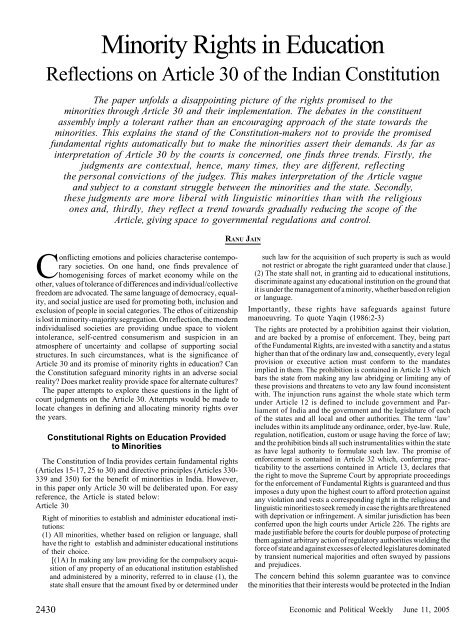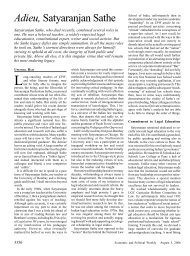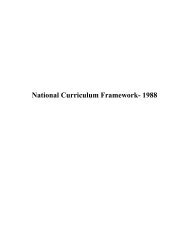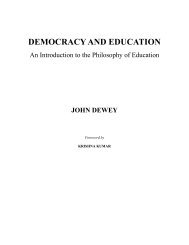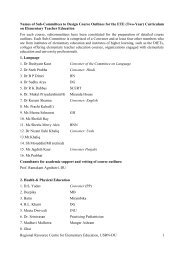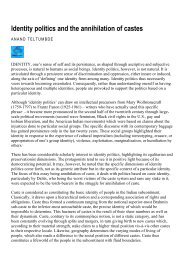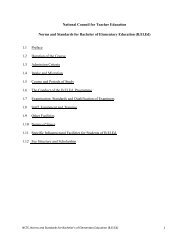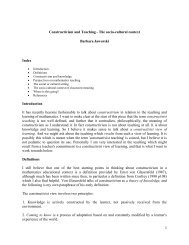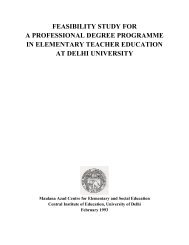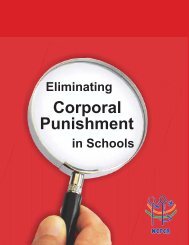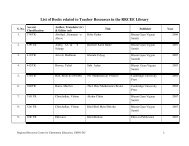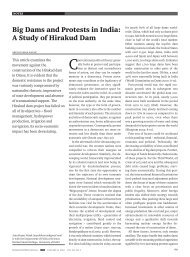Minority Rights in Education - eledu.net
Minority Rights in Education - eledu.net
Minority Rights in Education - eledu.net
Create successful ePaper yourself
Turn your PDF publications into a flip-book with our unique Google optimized e-Paper software.
<strong>M<strong>in</strong>ority</strong> <strong>Rights</strong> <strong>in</strong> <strong>Education</strong>Reflections on Article 30 of the Indian ConstitutionThe paper unfolds a disappo<strong>in</strong>t<strong>in</strong>g picture of the rights promised to them<strong>in</strong>orities through Article 30 and their implementation. The debates <strong>in</strong> the constituentassembly imply a tolerant rather than an encourag<strong>in</strong>g approach of the state towards them<strong>in</strong>orities. This expla<strong>in</strong>s the stand of the Constitution-makers not to provide the promisedfundamental rights automatically but to make the m<strong>in</strong>orities assert their demands. As far as<strong>in</strong>terpretation of Article 30 by the courts is concerned, one f<strong>in</strong>ds three trends. Firstly, thejudgments are contextual, hence, many times, they are different, reflect<strong>in</strong>gthe personal convictions of the judges. This makes <strong>in</strong>terpretation of the Article vagueand subject to a constant struggle between the m<strong>in</strong>orities and the state. Secondly,these judgments are more liberal with l<strong>in</strong>guistic m<strong>in</strong>orities than with the religiousones and, thirdly, they reflect a trend towards gradually reduc<strong>in</strong>g the scope of theArticle, giv<strong>in</strong>g space to governmental regulations and control.RANU JAINConflict<strong>in</strong>g emotions and policies characterise contemporarysocieties. On one hand, one f<strong>in</strong>ds prevalence ofhomogenis<strong>in</strong>g forces of market economy while on theother, values of tolerance of differences and <strong>in</strong>dividual/collectivefreedom are advocated. The same language of democracy, equality,and social justice are used for promot<strong>in</strong>g both, <strong>in</strong>clusion andexclusion of people <strong>in</strong> social categories. The ethos of citizenshipis lost <strong>in</strong> m<strong>in</strong>ority-majority segregation. On reflection, the modern<strong>in</strong>dividualised societies are provid<strong>in</strong>g undue space to violent<strong>in</strong>tolerance, self-centred consumerism and suspicion <strong>in</strong> anatmosphere of uncerta<strong>in</strong>ty and collapse of support<strong>in</strong>g socialstructures. In such circumstances, what is the significance ofArticle 30 and its promise of m<strong>in</strong>ority rights <strong>in</strong> education? Canthe Constitution safeguard m<strong>in</strong>ority rights <strong>in</strong> an adverse socialreality? Does market reality provide space for alternate cultures?The paper attempts to explore these questions <strong>in</strong> the light ofcourt judgments on the Article 30. Attempts would be made tolocate changes <strong>in</strong> def<strong>in</strong><strong>in</strong>g and allocat<strong>in</strong>g m<strong>in</strong>ority rights overthe years.Constitutional <strong>Rights</strong> on <strong>Education</strong> Providedto M<strong>in</strong>oritiesThe Constitution of India provides certa<strong>in</strong> fundamental rights(Articles 15-17, 25 to 30) and directive pr<strong>in</strong>ciples (Articles 330-339 and 350) for the benefit of m<strong>in</strong>orities <strong>in</strong> India. However,<strong>in</strong> this paper only Article 30 will be deliberated upon. For easyreference, the Article is stated below:Article 30Right of m<strong>in</strong>orities to establish and adm<strong>in</strong>ister educational <strong>in</strong>stitutions:(1) All m<strong>in</strong>orities, whether based on religion or language, shallhave the right to establish and adm<strong>in</strong>ister educational <strong>in</strong>stitutionsof their choice.[(1A) In mak<strong>in</strong>g any law provid<strong>in</strong>g for the compulsory acquisitionof any property of an educational <strong>in</strong>stitution establishedand adm<strong>in</strong>istered by a m<strong>in</strong>ority, referred to <strong>in</strong> clause (1), thestate shall ensure that the amount fixed by or determ<strong>in</strong>ed undersuch law for the acquisition of such property is such as wouldnot restrict or abrogate the right guaranteed under that clause.](2) The state shall not, <strong>in</strong> grant<strong>in</strong>g aid to educational <strong>in</strong>stitutions,discrim<strong>in</strong>ate aga<strong>in</strong>st any educational <strong>in</strong>stitution on the ground thatit is under the management of a m<strong>in</strong>ority, whether based on religionor language.Importantly, these rights have safeguards aga<strong>in</strong>st futuremanoeuvr<strong>in</strong>g. To quote Yaq<strong>in</strong> (1986:2-3)The rights are protected by a prohibition aga<strong>in</strong>st their violation,and are backed by a promise of enforcement. They, be<strong>in</strong>g partof the Fundamental <strong>Rights</strong>, are <strong>in</strong>vested with a sanctity and a statushigher than that of the ord<strong>in</strong>ary law and, consequently, every legalprovision or executive action must conform to the mandatesimplied <strong>in</strong> them. The prohibition is conta<strong>in</strong>ed <strong>in</strong> Article 13 whichbars the state from mak<strong>in</strong>g any law abridg<strong>in</strong>g or limit<strong>in</strong>g any ofthese provisions and threatens to veto any law found <strong>in</strong>consistentwith. The <strong>in</strong>junction runs aga<strong>in</strong>st the whole state which termunder Article 12 is def<strong>in</strong>ed to <strong>in</strong>clude government and Parliamentof India and the government and the legislature of eachof the states and all local and other authorities. The term ‘law’<strong>in</strong>cludes with<strong>in</strong> its amplitude any ord<strong>in</strong>ance, order, bye-law. Rule,regulation, notification, custom or usage hav<strong>in</strong>g the force of law;and the prohibition b<strong>in</strong>ds all such <strong>in</strong>strumentalities with<strong>in</strong> the stateas have legal authority to formulate such law. The promise ofenforcement is conta<strong>in</strong>ed <strong>in</strong> Article 32 which, conferr<strong>in</strong>g practicabilityto the assertions conta<strong>in</strong>ed <strong>in</strong> Article 13, declares thatthe right to move the Supreme Court by appropriate proceed<strong>in</strong>gsfor the enforcement of Fundamental <strong>Rights</strong> is guaranteed and thusimposes a duty upon the highest court to afford protection aga<strong>in</strong>stany violation and vests a correspond<strong>in</strong>g right <strong>in</strong> the religious andl<strong>in</strong>guistic m<strong>in</strong>orities to seek remedy <strong>in</strong> case the rights are threatenedwith deprivation or <strong>in</strong>fr<strong>in</strong>gement. A similar jurisdiction has beenconferred upon the high courts under Article 226. The rights aremade justifiable before the courts for double purpose of protect<strong>in</strong>gthem aga<strong>in</strong>st arbitrary action of regulatory authorities wield<strong>in</strong>g theforce of state and aga<strong>in</strong>st excesses of elected legislatures dom<strong>in</strong>atedby transient numerical majorities and often swayed by passionsand prejudices.The concern beh<strong>in</strong>d this solemn guarantee was to conv<strong>in</strong>cethe m<strong>in</strong>orities that their <strong>in</strong>terests would be protected <strong>in</strong> the Indian2430Economic and Political Weekly June 11, 2005
nation. This need was felt <strong>in</strong> the context of the heightenedm<strong>in</strong>ority-majority awareness <strong>in</strong> the British period. The divide andrule policy of the British had alienated m<strong>in</strong>orities. In addition,the identification of the Congress with the H<strong>in</strong>du upper castesby a dom<strong>in</strong>ant stratum of the m<strong>in</strong>ority furthered the fear ofsubjugation <strong>in</strong> post-<strong>in</strong>dependence India among the same. In thesecircumstances, constitutional guarantee of rights was consideredan effective means to dispel the fear and to conv<strong>in</strong>ce the m<strong>in</strong>oritiesof protection of their <strong>in</strong>terests <strong>in</strong> the <strong>in</strong>dependent India.However, Partition and the assass<strong>in</strong>ation of Mahatma Gandhiwere two mov<strong>in</strong>g forces that resulted <strong>in</strong> conf<strong>in</strong><strong>in</strong>g the rights ofthe m<strong>in</strong>orities, especially the religious m<strong>in</strong>orities, to socio-culturalfields like education and language.As has been mentioned earlier, the rights promised <strong>in</strong> the Constitutionare b<strong>in</strong>d<strong>in</strong>g on the state and even the legislative assemblycannot modify these rights. Further, <strong>in</strong>trusion of any nature onthese rights can be challenged <strong>in</strong> the court. However, the word<strong>in</strong>gof Article 30 were kept vague, leav<strong>in</strong>g much to the <strong>in</strong>terpretationof the judiciary, giv<strong>in</strong>g space to accommodate changes <strong>in</strong> thepolitical and value structures. To quote Yaq<strong>in</strong> (1986:45),While Article 23 of the Draft Constitution, correspond<strong>in</strong>g to thepresent Article 30, was be<strong>in</strong>g debated, doubts were <strong>in</strong>deed expressed<strong>in</strong> the Constituent Assembly over the advisability ofleav<strong>in</strong>g vague justifiable rights to undef<strong>in</strong>ed m<strong>in</strong>orities. The assemblychose to avoid any further elaboration and left it to the wisdomof the courts to supply this omission.A look at the court cases reveals regular and frequent <strong>in</strong>terpretationof these rights <strong>in</strong> both, the high court and the SupremeCourt. A few relevant <strong>in</strong>terpretations def<strong>in</strong><strong>in</strong>g implications ofthe Article 30, are discussed <strong>in</strong> the follow<strong>in</strong>g sections of the paper.Concept of <strong>M<strong>in</strong>ority</strong>‘<strong>M<strong>in</strong>ority</strong>’ as a concept has not been adequately def<strong>in</strong>ed <strong>in</strong>the Indian Constitution. Although mention<strong>in</strong>g the culturalattributes of religion and language, the Constitution does notprovide details on the geographical and numerical specificationof the concept. Even the specifics of language and religion arenot mentioned. In the constituent assembly debate on Article 23,B R Ambedkar (Constituent Assembly Debates, 1948-49:922-923) said,It will be noted that the term m<strong>in</strong>ority was used there<strong>in</strong> not <strong>in</strong>the technical sense of the word ‘m<strong>in</strong>ority’ as we have beenaccustomed to use it for the purposes of certa<strong>in</strong> political safeguards,such as representation <strong>in</strong> the Legislature, representation <strong>in</strong> theServices and so on. The word is used not merely to <strong>in</strong>dicate them<strong>in</strong>ority <strong>in</strong> the technical sense of the word, it is also used to coverm<strong>in</strong>orities which are not m<strong>in</strong>orities <strong>in</strong> the technical sense, butwhich are no<strong>net</strong>heless m<strong>in</strong>orities <strong>in</strong> the cultural and l<strong>in</strong>guisticsense. For <strong>in</strong>stance, for the purposes of this Article 23, if a certa<strong>in</strong>number of people from Madras came and settled <strong>in</strong> Bombay forcerta<strong>in</strong> purposes, they would be, although not a m<strong>in</strong>ority <strong>in</strong> thetechnical sense, cultural m<strong>in</strong>orities.... The article <strong>in</strong>tends to giveprotection <strong>in</strong> the matter of culture, language and script not onlyto a m<strong>in</strong>ority technically, but also to a m<strong>in</strong>ority <strong>in</strong> the wider senseof the terms as I have expla<strong>in</strong>ed just now.As early as 1958, <strong>in</strong> ‘In Re the Kerala <strong>Education</strong> Bill, 1957’(AIR 1958 SC 956) the Supreme Court suggested the techniqueof arithmetical tabulation of less than 50 per cent of populationfor identify<strong>in</strong>g a m<strong>in</strong>ority. This population was to be determ<strong>in</strong>ed<strong>in</strong> accordance to the applicability of the law <strong>in</strong> question. If anAct is applicable nationwide then the m<strong>in</strong>ority group would bedecided on the national figures and <strong>in</strong> the case of the Act be<strong>in</strong>gapplicable <strong>in</strong> a state, the m<strong>in</strong>ority group would be decided onthe state figures. However, the recent case of T M A Pai Foundationand Ors vs State of Karnataka and Ors (October 2002;now onwards Pai case) has specified the geographical entity ofstate for consideration of the status of m<strong>in</strong>ority for Article 30.To quote from the judgment (Judgments Today, 2002(9) SC 2)S<strong>in</strong>ce reorganisation of the states <strong>in</strong> India has been on l<strong>in</strong>guisticl<strong>in</strong>es, therefore, for the purpose of determ<strong>in</strong><strong>in</strong>g the m<strong>in</strong>ority, theunit will be the state and not the whole of India. Thus, religiousand l<strong>in</strong>guistic m<strong>in</strong>orities, who have been put at par <strong>in</strong> Article 30,have to be considered statewise.One fails to understand how organisation of states on l<strong>in</strong>guisticbasis provides a base for consideration of the states as the basicunit for arithmetical calculation for determ<strong>in</strong><strong>in</strong>g religious m<strong>in</strong>orities.Further, it is important to mention that the condition ofhav<strong>in</strong>g less than 50 per cent of the population <strong>in</strong> a state, dist<strong>in</strong>guishableon religious or l<strong>in</strong>guistic terms, does not entitle o<strong>net</strong>o the rights automatically. In the words of Ambedkar (ConstituentAssembly Debates, 1948-49: 923),I th<strong>in</strong>k another th<strong>in</strong>g which has to be borne <strong>in</strong> m<strong>in</strong>d <strong>in</strong> read<strong>in</strong>garticle 23 is that it does not impose any obligation or burden uponthe State. It does not say that, when for <strong>in</strong>stance the Madras peoplecome to Bombay, the Bombay government shall be required bylaw to f<strong>in</strong>ance any project of giv<strong>in</strong>g education either <strong>in</strong> Tamillanguage or <strong>in</strong> Andhra language or any other language...The onlylimitation that is imposed by article 23 is that if there is a culturalm<strong>in</strong>ority which wants to preserve its language, its script and itsculture, the State shall not by law impose upon it any other culturewhich may be either local or otherwise. Therefore this article reallyis to be read <strong>in</strong> a much wider sense and does not apply only towhat I call the technical m<strong>in</strong>orities as we use it <strong>in</strong> our Constitution.Succ<strong>in</strong>ctly, it is left to the m<strong>in</strong>ority to establish its m<strong>in</strong>oritystatus <strong>in</strong> order to avail the benefits of the Article 30. The taskis difficult especially because the concepts of ‘religion’ and‘language’ have not been adequately def<strong>in</strong>ed <strong>in</strong> the article or theconstituent assembly debates. Does the concept of language referto the languages hav<strong>in</strong>g adequately developed grammar and scriptor only script is sufficient to claim the status or is spoken languagea condition enough to acquire the status of m<strong>in</strong>ority?As far as language is concerned, the case of D A V College,Jullunder vs State of Punjab (AIR 1971 SC 1737) is consideredimportant. In this case, the Court observed,A l<strong>in</strong>guistic m<strong>in</strong>ority for the purpose of Article 30(1) is one whichmust at least have a separate spoken language. It is not necessarythat that language should also have a dist<strong>in</strong>ct script for those whospeak it.As far as the concept of religion is concerned, can a sect claimthe status of m<strong>in</strong>ority? Does the Article accept only major wellrecognised religions or emerg<strong>in</strong>g religions can also avail of thebenefits? In the latter case, how can it be established that thereligion is new and is not merely a sect?A study of court cases reveals a cont<strong>in</strong>uous struggle betweenthe State and m<strong>in</strong>orities on these issues. For <strong>in</strong>stance, Patna HighCourt announced Arya Samaj [Arya Prat<strong>in</strong>idhi Sabha vs Stateof Bihar (AIR 1958, Patna 359)], a m<strong>in</strong>ority dist<strong>in</strong>ct from theH<strong>in</strong>dus. However, <strong>in</strong> 1976, Delhi High Court decided aga<strong>in</strong>stprovid<strong>in</strong>g benefits of Article 30 to denom<strong>in</strong>ations and sects. Toquote Desai (1996:34)The most significant case on this issue was decided by the DelhiHigh Court <strong>in</strong> 1976…It lays down the correct position <strong>in</strong> law namelyEconomic and Political Weekly June 11, 2005 2431
that ‘m<strong>in</strong>orities based on religion’ <strong>in</strong> Article 30(1) mean only whatwe call <strong>in</strong> common parlance the various religious communitieslike H<strong>in</strong>dus, Muslims, Sikhs, Buddhists, Christians, Ja<strong>in</strong>s, etc, andcannot be meant to <strong>in</strong>clude religious denom<strong>in</strong>ations or sects.One gets uncomfortable on such verdicts. Acceptance of onlyascriptive and well-recognised units as religious units does nottake <strong>in</strong>to account new religious movements and claims of newemergent religious groups for m<strong>in</strong>ority rights. In 1962, BrahmoSamaj of Bihar made this claim, which was accepted by the HighCourt [Dipendra Nath Sarkar vs State of Bihar (AIR 1962 Patna101)]. The court, however, did not accept such a claim <strong>in</strong> thecases of Chaudhari Janki Prasad (AIR 1974 PAT 187) andS P Mittal (AIR 1983 SC 1).The ambiguous def<strong>in</strong>ition of religion has potential for controversy.Unfortunately, the bench compris<strong>in</strong>g 11 judges <strong>in</strong> thePai case did not deliberate upon this important issue; hence,leav<strong>in</strong>g space for cont<strong>in</strong>ued confusion at the levels of both, thestate and the m<strong>in</strong>orities.Conditions for Establish<strong>in</strong>gand Adm<strong>in</strong>ister<strong>in</strong>g an InstitutionArticle 30(1) gives l<strong>in</strong>guistic and religious m<strong>in</strong>orities a fundamentalright to establish and adm<strong>in</strong>ister educational <strong>in</strong>stitutionsof their choice. In the case of St Stephan’s College (AIR1992 SC 1630) it was stated,…the words “establish” and “adm<strong>in</strong>ister” used <strong>in</strong> Article 30(1)are to be read conjunctively. The right claimed by a m<strong>in</strong>oritycommunity to adm<strong>in</strong>ister the educational <strong>in</strong>stitution depends uponthe proof of establishment of the <strong>in</strong>stitution. The proof of establishmentof the <strong>in</strong>stitution, is thus a condition precedent forclaim<strong>in</strong>g the right to adm<strong>in</strong>ister the <strong>in</strong>stitution.One gets surprised at this condition. Why does a m<strong>in</strong>ority haveto establish an <strong>in</strong>stitution <strong>in</strong> order to adm<strong>in</strong>ister it? Transfer ofmanagement <strong>in</strong> the private educational <strong>in</strong>stitutions is not a rarephenomenon <strong>in</strong> India. Accord<strong>in</strong>g to Desai, (1996:79)The logic beh<strong>in</strong>d this is rather <strong>in</strong>comprehensible. The only reasongiven for this <strong>in</strong>terpretation is that the word ‘and’ and not the word‘or’ is used between the words ‘establish’ and ‘adm<strong>in</strong>ister’.To quote Desai aga<strong>in</strong> (1996:80)In my submission the word ‘and’ used <strong>in</strong> Article 30(1) of theConstitution should have been <strong>in</strong>terpreted <strong>in</strong> a disjunctive andnot <strong>in</strong> a conjunctive sense. There is need to adopt ‘purposive’rather than ‘literal’ <strong>in</strong>terpretation of the Constitution…Therationale beh<strong>in</strong>d Article 30(1) is to give protection to m<strong>in</strong>oritiesto run educational <strong>in</strong>stitution of their choice. Why should itmatter that the educational <strong>in</strong>stitution presently run by the m<strong>in</strong>orityfor the benefit of the m<strong>in</strong>ority was established, may be a centuryback, by persons not belong<strong>in</strong>g to a m<strong>in</strong>ority community?... The<strong>in</strong>tent of the Article seems to be that not only does a m<strong>in</strong>orityhave the right to run an exist<strong>in</strong>g <strong>in</strong>stitution but also to establisheducational <strong>in</strong>stitutions and vice versa. This appears to be theonly logic consistent with the historical background of m<strong>in</strong>orityrights. Be that as it may, the settled position <strong>in</strong> law is that a m<strong>in</strong>oritycannot adm<strong>in</strong>ister an <strong>in</strong>stitution which it has not established.At least <strong>in</strong> the case of A M Patroni (AIR 1974 KER 197) thecourt is <strong>in</strong> agreement with Desai,…even if an <strong>in</strong>stitution previously run by some other organisationis subsequently taken over by a m<strong>in</strong>ority community and runby it, it must be held that it was established by that m<strong>in</strong>oritycommunity.One wonders why this facilitat<strong>in</strong>g and liberal approach has notbeen popular with the court. The conjunctive approach has putmany <strong>in</strong>stitutions for the m<strong>in</strong>orities <strong>in</strong> the general category thusdepriv<strong>in</strong>g them to avail of the benefits of the Article. Examplecan be given of Aligarh Muslim University. Further, the word‘establish’ <strong>in</strong> relation to the Article 30(1) has been <strong>in</strong>terpretedas, ‘to br<strong>in</strong>g <strong>in</strong>to existence’ (AIR 1968 SC 663). But what exactlydoes this mean? Does this mean that the m<strong>in</strong>ority communityshould take <strong>in</strong>itiative to start the <strong>in</strong>stitution? Or, that the nameand the management should reflect the m<strong>in</strong>ority orientation? Or,that the <strong>in</strong>stitution should be established for benefit of them<strong>in</strong>ority community only? In State of Kerala vs Mother Prov<strong>in</strong>cial(AIR 1970 SC 2082), Supreme Court made the follow<strong>in</strong>g<strong>in</strong>terpretation,The first right is the <strong>in</strong>itial right to establish <strong>in</strong>stitutions of them<strong>in</strong>ority’s choice. Establishment here means the br<strong>in</strong>g<strong>in</strong>g <strong>in</strong>to be<strong>in</strong>gof an <strong>in</strong>stitution and it must be by a m<strong>in</strong>ority community. It mattersnot if a s<strong>in</strong>gle philanthropic <strong>in</strong>dividual with his own means, foundsthe <strong>in</strong>stitution or the community at large contributes the funds.However, mere establishment by a person from a m<strong>in</strong>oritycommunity does not entitle the <strong>in</strong>stitute to the m<strong>in</strong>ority status.To quote from the case of Rajershi Memorial Basic Tra<strong>in</strong><strong>in</strong>gSchool (AIR 1973 Kerala 88),The mere fact that the school was founded by a person belong<strong>in</strong>gto a particular religious persuasion is not at all conclusive on thismatter. The <strong>in</strong>stitution must be shown to be one established…byor on behalf of the particular m<strong>in</strong>ority community.In the case of Fr Mathew Munthiri Ch<strong>in</strong>thyil Vicar, St Mary’sChurch Anikkampoil vs State of Kerala, the court held that thegovernmental master plan, which prescribes permissible numberof schools <strong>in</strong> a locality, has to be followed while select<strong>in</strong>g alocation for establish<strong>in</strong>g a m<strong>in</strong>ority educational <strong>in</strong>stitution. TheHigh Court of Kerala (AIR 1978 KER 227) rejected petition forestablish<strong>in</strong>g a new school on the same ground. It stated,An extreme position entitl<strong>in</strong>g the m<strong>in</strong>ority to ask, and to be given,the educational <strong>in</strong>stitutions, wherever it wants to establish, at anymoment when the cry is raised, is not the scope and the contentof Art 30. Regulation of the right <strong>in</strong> time as well as <strong>in</strong> space, mustbe permissible.Desai states (1996:87-88),The Court rejected the Petition but held that <strong>in</strong> weigh<strong>in</strong>g the needsof the locality, the authority was bound to consider the requirementsof the m<strong>in</strong>ority communities <strong>in</strong> establish<strong>in</strong>g educational<strong>in</strong>stitutions of their choice.In this context, it is <strong>in</strong>terest<strong>in</strong>g to note that <strong>in</strong> the cases of SocioLegal Advancement Society vs State of Karnataka (AIR 1989KER 217) and Mark Netto vs Government of Kerala (AIR 1979SC 83) courts took a different view. In these cases it was statedthat a m<strong>in</strong>ority community could not be stopped from establish<strong>in</strong>gan educational <strong>in</strong>stitution.<strong>Education</strong> of Their ChoicePreservation of culture, as such, is not a necessary conditioneither for acquir<strong>in</strong>g the status of m<strong>in</strong>ority or for claim<strong>in</strong>g rightsunder Article 30. In Re the Kerala <strong>Education</strong> Bill 1957 (AIR1958 SC 959) chief justice S R Das stated,The key to the understand<strong>in</strong>g of the true mean<strong>in</strong>g and implicationof the article under consideration are the words “of their ownchoice”. It is said that the dom<strong>in</strong>ant word is “choice” and the2432Economic and Political Weekly June 11, 2005
content of that article is as wide as the choice of the particularm<strong>in</strong>ority community may make it.To quote him aga<strong>in</strong> (AIR 1958 SC 979),There is no limitation placed on the subjects to be taught <strong>in</strong> sucheducational <strong>in</strong>stitutions. As such m<strong>in</strong>orities will ord<strong>in</strong>arily desirethat their children should be brought up properly and efficientlyand be eligible for higher university education and go out <strong>in</strong> theworld fully equipped with such <strong>in</strong>tellectual atta<strong>in</strong>ments as will makethem fit..., educational <strong>in</strong>stitutions of their choice will necessarily<strong>in</strong>clude <strong>in</strong>stitutions impart<strong>in</strong>g general secular education also.This view is confirmed <strong>in</strong> the case of St Xavier’s College vs Stateof Gujarat (AIR 1974 SC 1389) by a bench of n<strong>in</strong>e court judges.However, <strong>in</strong> the All Sa<strong>in</strong>t’s High School (AIR 1980 SC 1043), thecourt laid down broad pr<strong>in</strong>ciples for determ<strong>in</strong><strong>in</strong>g syllabus. It statesWhere a m<strong>in</strong>ority <strong>in</strong>stitution is affiliated to a university the factthat it is enjo<strong>in</strong>ed to adopt the courses of study or the syllabi orthe nature of books prescribed and the hold<strong>in</strong>g of exam<strong>in</strong>ationto test the ability of the students of the <strong>in</strong>stitution concerned doesnot violate the freedom conta<strong>in</strong>ed <strong>in</strong> Article 30 of the Constitution.M<strong>in</strong>orities have been given a right to select medium of <strong>in</strong>struction(AIR 1954 SC 561) for their educational <strong>in</strong>stitutions. TheD A V College, Chandigarh (AIR 1971 SC 1746) made standpo<strong>in</strong>tof the court clear,Neither the University nor the State can provide for impart<strong>in</strong>geducation <strong>in</strong> a medium of <strong>in</strong>struction <strong>in</strong> a language and script whichstifles the language and script of any Section of the citizens. Sucha course will trespass on the rights of those Sections of the citizenswhich have a dist<strong>in</strong>ct language or script and which they have aright to conserve through educational <strong>in</strong>stitutions of their own.However, “the State can provide for the study of the Statelanguage as compulsory second language” [Desai 1996:206].It is important to note <strong>in</strong> this context that even the aided educational<strong>in</strong>stitutions established by the religious m<strong>in</strong>orities cannotimpart religious education unless such provision is made <strong>in</strong> thetrust deed of the <strong>in</strong>stitution. Unaided or partially aided m<strong>in</strong>ority<strong>in</strong>stitutions are free to impart religious <strong>in</strong>structions to the students.Scope for Government ControlAdm<strong>in</strong>istration of an <strong>in</strong>stitution requires constant <strong>in</strong>teractionamong the management of the <strong>in</strong>stitution and the government.As the <strong>in</strong>terests of the two are different, this generates manyconflict<strong>in</strong>g situations. Some of the contested issues are mentioned<strong>in</strong> the Pai case (Judgments Today, 2002(9) SC 15), where…it was submitted that the state should not have a right to <strong>in</strong>terfereor lay down conditions with regard to the adm<strong>in</strong>istration of…<strong>in</strong>stitutions. In particular, objection was taken to the nom<strong>in</strong>ationsby the state on the govern<strong>in</strong>g bodies of the private <strong>in</strong>stitutions, aswell as to provisions with regard to the manner of admitt<strong>in</strong>gstudents, the fix<strong>in</strong>g of the fee structure and recruitment of teachersthrough state channels.Varied <strong>in</strong>terpretation of Article 30, especially with referenceto Articles 29, is yet another cause of the tension between theGovernment and the educational <strong>in</strong>stitutions. The state’s suspicionof the m<strong>in</strong>orities especially the religious ones; evidence of misuseof provisions of Article 30; and the desire of the m<strong>in</strong>orities toavail of their Constitutional rights, especially <strong>in</strong> a state regulatededucation system are yet some more reasons for the same.<strong>M<strong>in</strong>ority</strong> educational <strong>in</strong>stitutions, <strong>in</strong> general, are educationalbodies operative <strong>in</strong> the formal educational system of India. Hence,the rules and regulations prescribed for private <strong>in</strong>stitutions bythe state, are applicable to the m<strong>in</strong>ority <strong>in</strong>stitutions unlessotherwise stated. It is also important to note that these rules andregulations cover almost every aspect of the educational <strong>in</strong>stitutionsespecially of those, which avail benefits of governmentrecognition/aid or are affiliated to universities.<strong>M<strong>in</strong>ority</strong> educational <strong>in</strong>stitutions have a right to governmentrecognition/aid or even affiliation to an university. Accord<strong>in</strong>gto Justice Das, “...to deny recognition to the educational <strong>in</strong>stitutionsexcept upon terms tantamount to the surrender of theirconstitutional right of adm<strong>in</strong>istration of the educational <strong>in</strong>stitutionsof their choice is <strong>in</strong> truth and <strong>in</strong> effect to deprive them oftheir rights under Article 30(1)” (AIR 1958 SC 985). He says,“Without recognition, therefore, the educational <strong>in</strong>stitutionsestablished or to be established by the m<strong>in</strong>ority communitiescannot fulfil the real objects of their choice and the rights underArticle 30(1) cannot be efficiently exercised” (ibid). In the caseof St Xavier’s College vs State of Gujarat (AIR 1974 SC 1395),it has been stated that “the establishment of a m<strong>in</strong>ority <strong>in</strong>stitutionis not only <strong>in</strong>effective but also unreal unless such <strong>in</strong>stitution isaffiliated to a University for the purpose of conferment of degreeson students”. However, “any law which provides for affiliationon terms which will <strong>in</strong>volve abridgement of the right of l<strong>in</strong>guisticand religious m<strong>in</strong>orities to adm<strong>in</strong>ister and establish educational<strong>in</strong>stitutions of their choice will offend Article 30(1)”.Article 30 covers rights to recognition and affiliation, which<strong>in</strong>cludes rights to receive f<strong>in</strong>ancial aid from the state; to selectmanagement bodies, staff, and students; and, to select contentof education. But, a look at the judicial decision reveals that theserights are not absolute <strong>in</strong> nature. Justice Reddy J (AIR 1974SC 1407) summarises the position,The only purpose that the fundamental right under Article 30(1)would serve would <strong>in</strong> that case be that m<strong>in</strong>orities may establishtheir <strong>in</strong>stitutions, lay down their own syllabi, provide <strong>in</strong>structions<strong>in</strong> the subjects of their choice, conduct exam<strong>in</strong>ations and awarddegrees or diplomas. Such <strong>in</strong>stitutions have the right to seekrecognition to their degrees and diplomas and ask for aid whereaid is given to other educational <strong>in</strong>stitutions giv<strong>in</strong>g a like educationon the basis of the excellence achieved by them. The state is boundto give recognition to their qualifications and to the <strong>in</strong>stitutionsand they cannot be discrim<strong>in</strong>ated except on the ground of wantof excellence <strong>in</strong> their educational standards so far as recognitionof degrees or educational qualifications is concerned and want ofefficient management so far as aid is concerned.The case of St Xavier’s College specifies the scope of controlover the m<strong>in</strong>ority educational <strong>in</strong>stitutions (AIR 1974 SC 1389).Accord<strong>in</strong>g to chief justice Ray, the government can regulatecourse of the study, qualification and appo<strong>in</strong>tment of teachers,conditions of employment of teachers, health and hygiene ofstudents, facilities for libraries and laboratories. The court alsotalked about the need of such measures as would br<strong>in</strong>g aboutuniformity, efficiency and excellence <strong>in</strong> educational matters.Further to the conditions of merit, excellence and uniformity,the court states “The right to adm<strong>in</strong>ister cannot obviously <strong>in</strong>cludethe right to maladm<strong>in</strong>ister” (AIR 1958 SC 982).Although agree<strong>in</strong>g with the court judgments <strong>in</strong> pr<strong>in</strong>ciple andacknowledg<strong>in</strong>g the need to keep a m<strong>in</strong>imum check on the educational<strong>in</strong>stitutions for provid<strong>in</strong>g quality education to the beneficiaries,one cautions that concepts like uniformity, maladm<strong>in</strong>istrationand excellence provide undue space for governmentalcontrol over the m<strong>in</strong>ority education <strong>in</strong>stitutions. For <strong>in</strong>stance, theSupreme Court <strong>in</strong> the case of Sidhrajbhai vs State of Gujaratstated, “Regulations made <strong>in</strong> the true <strong>in</strong>terest of efficiency ofEconomic and Political Weekly June 11, 2005 2433
<strong>in</strong>stitution, discipl<strong>in</strong>e, health, sanitation, morality, public orderand the like may undoubtedly be imposed. Such regulations arenot restrictions on the substance of the right which is guaranteed:they secure the proper function<strong>in</strong>g of the <strong>in</strong>stitutions, <strong>in</strong> matterseducational” (AIR 1963 SC 540-41). Chief Justice Hidayatullah(AIR 1970 SC 2082) adds,... the standards of education are not a part of management as such.These standards concern the body politic and are dictated byconsiderations of the advancement of the country and its people.Therefore, if universities establish the syllabi for exam<strong>in</strong>ations,they must be followed subject, however, to special subjects, whichthe <strong>in</strong>stitutions may seek to teach...Such regulations do not beardirectly upon management as such although they may <strong>in</strong>directlyaffect it. Yet the right of the State to regulate education, educationalstandards and allied matters cannot be denied.Control over the m<strong>in</strong>ority educational <strong>in</strong>stitutions is practisednot only for ensur<strong>in</strong>g academic standards, but also for safeguard<strong>in</strong>g<strong>in</strong>terest of the employees. While the management of them<strong>in</strong>ority educational <strong>in</strong>stitution has right to take discipl<strong>in</strong>aryaction aga<strong>in</strong>st its employees <strong>in</strong> accordance to the service rulesof the <strong>in</strong>stitution, the state is entitled to take regulatory measuresto ensure security of the services and <strong>in</strong>terests of the academicand non-academic staff of the <strong>in</strong>stitution. Outside authorities like,the vice-chancellor and his/her nom<strong>in</strong>ee can be <strong>in</strong>troduced <strong>in</strong> theadm<strong>in</strong>istrative bodies of the <strong>in</strong>stitution, however, the role of suchauthorities should be well specified and should be such as notto overshadow the powers of the manag<strong>in</strong>g committee. To quotefrom the case of All Sa<strong>in</strong>ts High School vs Government of AP(AIR 1980 SC 1043),It is, therefore, open to the government or the university to framerules and regulations govern<strong>in</strong>g the conditions of service of teachers<strong>in</strong> order to secure their tenure of service and to appo<strong>in</strong>t a highauthority armed with sufficient guidance to see that the said rulesare not violated or that members of the staff are not arbitrarilytreated or <strong>in</strong>nocently victimised...But while sett<strong>in</strong>g up such anauthority care must be taken to see that the said authority is notgiven blanket and uncanalised and arbitrary powers so as to actat their own sweet will, ignor<strong>in</strong>g the very spirit and objective ofthe <strong>in</strong>stitution. It would be better if the authority concernedassociates the members of the govern<strong>in</strong>g body or its nom<strong>in</strong>ee <strong>in</strong>its deliberation so as to <strong>in</strong>still confidence <strong>in</strong> the founders of the<strong>in</strong>stitution or the committees constituted by them.....the authority concerned must be provided with proper guidel<strong>in</strong>esunder the restricted field which they have to cover...In some cases,the outside authorities enjoy absolute powers <strong>in</strong> tak<strong>in</strong>g decisionsregard<strong>in</strong>g the m<strong>in</strong>ority <strong>in</strong>stitutions without hear<strong>in</strong>g them and theseorders are b<strong>in</strong>d<strong>in</strong>g on the <strong>in</strong>stitution. Such a course of action isnot constitutionally permissible so far as m<strong>in</strong>ority <strong>in</strong>stitution isconcerned because it directly <strong>in</strong>terferes with the adm<strong>in</strong>istrativeautonomy of the <strong>in</strong>stitution. A provision for an appeal or revisionaga<strong>in</strong>st the order of the authority by the aggrieved member of thestaff alone or the sett<strong>in</strong>g up of an Arbitration Tribunal is also notpermissible because Ray C J po<strong>in</strong>ted out <strong>in</strong> AIR 1974 SC 1389that such a course of action <strong>in</strong>troduces an arena of litigation andwould <strong>in</strong>volve the <strong>in</strong>stitution <strong>in</strong> unend<strong>in</strong>g litigation, thus impair<strong>in</strong>geducational efficiency of the <strong>in</strong>stitution…In this context, it is pert<strong>in</strong>ent to share a case of Bombayuniversity discussed by Gursahani <strong>in</strong> 1989 <strong>in</strong> ‘Practical Tra<strong>in</strong><strong>in</strong>gSeries of Lectures organised by the Maharashtra State Bar Councilfor Jr Advocates at Government Law College’ (cf BombayUniversity File number 118). He po<strong>in</strong>ted out that Section 42 A(i)of the Bombay University Act 1974, permits the state governmentto constitute <strong>in</strong> consultation with the Bombay university, one ormore college tribunals for adjudication of disputes or differencesbetween the employees and the management of any college orrecognised <strong>in</strong>stitution. Section 42 B of the Act considers decisionsof such tribunals as f<strong>in</strong>al and not appealable. Gursahani statesthat m<strong>in</strong>ority educational <strong>in</strong>stitutions had challenged the validityof the Constitution of the college tribunal and had submitted thatSection 42 B(1) of the Bombay University Act violate Article30(1). Likewise, high schools managed by the m<strong>in</strong>ority<strong>in</strong>stitutions had challenged the constitution of school tribunalwhich is constituted under 8(1) of the Maharashtra Employeesof Private Schools (Conditions of Service) Regulation Act 1977and the Maharashtra of Private Schools (Conditions of Service)Rules 1981. The statute for appo<strong>in</strong>tment of officers of the collegetribunals by the state <strong>in</strong> consultation with the university ofBombay was also challenged. A division bench of the BombayHigh Court consist<strong>in</strong>g of Justice P B Sawant and Justice G HGuttal deliberated on the issues and gave their judgment onJune 29, 1987. They held that m<strong>in</strong>ority educational <strong>in</strong>stitutions andtheir staff would be governed by the provisions of the UniversityAct 1974, under Section 42, and would be amenable to thejurisdiction of the college and school tribunals. They, however,said that the state government should appo<strong>in</strong>t the presid<strong>in</strong>g officer<strong>in</strong> consultation with the high court and not the Bombay university.Draw<strong>in</strong>g attention to the differences <strong>in</strong> the court op<strong>in</strong>ion, S<strong>in</strong>gh(S<strong>in</strong>gh P, nd) shares,...<strong>in</strong> Lily Kurien [Lily Kurien vs Sr Lew<strong>in</strong>a (1979) 2 SC 124] aprovision enabl<strong>in</strong>g an aggrieved member of the staff of a collegeto make an appeal to the vice-chancellor aga<strong>in</strong>st an order ofsuspension and other penalties was held to be violative of Article30(1). Aga<strong>in</strong>, <strong>in</strong> All Sa<strong>in</strong>ts High School [All Sa<strong>in</strong>ts HighSchool, Hyderabad vs Government of Andhra Pradesh (1980) 2SC 478] a provision conta<strong>in</strong>ed <strong>in</strong> Andhra Pradesh Private <strong>Education</strong>alInstitutions Control Act 1975 requir<strong>in</strong>g prior approvalof the competent authority of all orders of dismissal, removal orreduction <strong>in</strong> rank passed aga<strong>in</strong>st a teacher by the management ofcollege was held to be <strong>in</strong>applicable to a m<strong>in</strong>ority <strong>in</strong>stitution.Chandrachud, C J and Fazal Ali J found that the unqualified powergiven to an outside authority constituted an <strong>in</strong>terference with them<strong>in</strong>ority’s right to adm<strong>in</strong>ister their education <strong>in</strong>stitutions...ButKailasam J disagreed and upheld all these provisions as promotiveof excellence <strong>in</strong> the adm<strong>in</strong>istration of a m<strong>in</strong>ority <strong>in</strong>stitution byprevent<strong>in</strong>g the abuse of power.Concepts like excellence, maladm<strong>in</strong>istration and uniformityresult <strong>in</strong> subjective <strong>in</strong>terpretation of the Article, <strong>in</strong>fluenc<strong>in</strong>gdecisions of the court. Differences <strong>in</strong> the decisions, even whencontextually relevant, make the provisions under Article 30ambiguous, mak<strong>in</strong>g related issues a bone of contention amongthe m<strong>in</strong>orities and the state.Earlier, these provisions were considered applicable only onthe aided educational <strong>in</strong>stitutions but the Pai case (JudgmentsToday, 2002(9) SC 7-8) extended their scope to <strong>in</strong>clude eventhe unaided educational <strong>in</strong>stitutions.…<strong>in</strong> the case of unaided <strong>in</strong>stitutions the regulatory measures ofcontrol should be m<strong>in</strong>imal. Conditions of recognition and affiliationto an university or board have to be complied with. Managementsshould have freedom with regard to day-to-day management<strong>in</strong>clud<strong>in</strong>g appo<strong>in</strong>tment of teach<strong>in</strong>g and non teach<strong>in</strong>g staff andadm<strong>in</strong>istrative control over them. Rational procedure for selectionof teach<strong>in</strong>g staff and for tak<strong>in</strong>g discipl<strong>in</strong>ary action should beevolved. Appropriate tribunals should be constituted for redress<strong>in</strong>gthe grievances of employees of aided and unaided <strong>in</strong>stitutions. Itis open to the state or the controll<strong>in</strong>g authority to prescribe them<strong>in</strong>imum qualifications, experience and other conditions for be<strong>in</strong>g2434Economic and Political Weekly June 11, 2005
appo<strong>in</strong>ted as teacher or pr<strong>in</strong>ciple. Regulations can be framedgovern<strong>in</strong>g service conditions for teachers and other staff for whomaid is provided by state without <strong>in</strong>terfer<strong>in</strong>g with the overalladm<strong>in</strong>istrative control of the management over the staff. Fees tobe charged by the unaided <strong>in</strong>stitutions cannot be regulated butno <strong>in</strong>stitution should charge capitation fee...the pr<strong>in</strong>ciple that thereshould be no capitation fee or profiteer<strong>in</strong>g is correct.Relation between Articles 30 and 29In general, courts <strong>in</strong> India put Articles 29(2) and 30 together.This affects the implementation of the provisions of Article 30.For easy reference Article 29 is quoted below:Article 29 – Protection of <strong>in</strong>terests of m<strong>in</strong>orities:(1) Any section of the citizens resid<strong>in</strong>g <strong>in</strong> the territory of Indiaor any part thereof hav<strong>in</strong>g dist<strong>in</strong>ct language, script or culture ofits own shall have the right to conserve the same.(2) No citizen shall be denied admission <strong>in</strong>to any educational<strong>in</strong>stitution ma<strong>in</strong>ta<strong>in</strong>ed by the state or receiv<strong>in</strong>g aid out of state fundson grounds only of religion, race, caste, language or any of them.A careful read<strong>in</strong>g reveals an <strong>in</strong>tr<strong>in</strong>sic difference between thetwo Articles. Whereas Article 30 provides exclusive right toestablish and adm<strong>in</strong>ister educational <strong>in</strong>stitutions to the l<strong>in</strong>guisticand religious m<strong>in</strong>orities, Article 29(2) provides <strong>in</strong>discrim<strong>in</strong>ateright to admission <strong>in</strong> government-ssponsored and adm<strong>in</strong>isterededucational <strong>in</strong>stitutions to the citizens of India.In the case of St. Xavier’s College vs State of Gujarat (AIR1974 SC 1389), a bench of n<strong>in</strong>e judges was called to determ<strong>in</strong>ethe <strong>in</strong>terrelationship between Articles 29 and 30. All the n<strong>in</strong>ejudges were unanimous <strong>in</strong> their op<strong>in</strong>ion that Articles 29(1)and 30(1) deal with dist<strong>in</strong>ct matters and may be consideredsupplement<strong>in</strong>g each other so far as certa<strong>in</strong> cultural rights ofm<strong>in</strong>orities are concerned. However, the relation between clause (1)of Article 30 and clause (2) of Article 29 is paradoxical generat<strong>in</strong>gconfusions like; can m<strong>in</strong>ority education <strong>in</strong>stitutions deny admissionto any student on the basis of religion or language? Whether<strong>in</strong> admission to m<strong>in</strong>ority education <strong>in</strong>stitutions, preferences canbe given to m<strong>in</strong>ority students, overrul<strong>in</strong>g the criteria of merit?In the case of Ashu Gupta (AIR 1987 P& H 227), the courtheld that unaided m<strong>in</strong>ority <strong>in</strong>stitutions have complete freedomto select their students. It held that all m<strong>in</strong>ority <strong>in</strong>stitutions notreceiv<strong>in</strong>g aid from the government ‘are wholly out of the ambitof Article 29(2)’. In the case of Sidhrajbhai vs State of Gujarat(AIR 1963 SC 540), the court held that <strong>in</strong> government aidedm<strong>in</strong>ority <strong>in</strong>stitutions, government can neither nom<strong>in</strong>ate studentsnor reserve seats for backward classes. In the case of SheetansuSrivastava (AIR 1989 ALL 117) the court held that neither thegovernment could direct a m<strong>in</strong>ority <strong>in</strong>stitution to admit particularstudents nor a m<strong>in</strong>ority <strong>in</strong>stitution could deny admission to studentson the basis of their not belong<strong>in</strong>g to the m<strong>in</strong>ority community.The case of St Stephan’s College (AIR 1992 SC 1654) decidedby a bench of five judges of the Supreme Court is a landmarkcase as far as relation between Article 29(2) and Article 30(1)is concerned. Tackl<strong>in</strong>g the issue of admission the court stated,In the <strong>in</strong>stant case also the impugned directives of the universityto select students on the uniform basis of marks secured <strong>in</strong> thequalify<strong>in</strong>g exam<strong>in</strong>ations would deny the right of St Stephan’sCollege to admit students belong<strong>in</strong>g to Christian community. Ithas been the experience of the college as seen from the chart ofselection produced <strong>in</strong> the case that unless some concession isprovided to Christian students they will have no chance of gett<strong>in</strong>g<strong>in</strong>to the college. If they are thrown <strong>in</strong>to competition with thegenerality of students belong<strong>in</strong>g to other communities, they cannoteven be brought with<strong>in</strong> the zone of consideration for the <strong>in</strong>terview.Even after giv<strong>in</strong>g concession to a certa<strong>in</strong> extent, only a t<strong>in</strong>y numberof m<strong>in</strong>ority applicants would ga<strong>in</strong> admission. This is beyond thepale of controversy.However, keep<strong>in</strong>g <strong>in</strong> view the ever-<strong>in</strong>creas<strong>in</strong>g communalatmosphere of the nation, the court, <strong>in</strong> the same case (AIR 1992SC 1659), advocated the theory of melt<strong>in</strong>g pot and attemptedto strike a balance between the two Articles. It stated,In the nation build<strong>in</strong>g with secular character sectarian schools orcolleges; segregated faculties or universities for impart<strong>in</strong>g generalsecular education are undesirable and they may underm<strong>in</strong>e seculardemocracy. They would be <strong>in</strong>consistent with the central conceptof secularism and equality embedded <strong>in</strong> the Constitution. Everyeducational <strong>in</strong>stitution irrespective of the community to which itbelongs is a ‘melt<strong>in</strong>g pot’ <strong>in</strong> our national life. The students andteachers are the critical <strong>in</strong>gredients. It is there they develope respectfor, and tolerance of, the cultures and beliefs of others. It is essentialtherefore, that there should be proper mix of students of differentcommunities <strong>in</strong> all educational <strong>in</strong>stitutions.It further states (AIR 1992 SC 1663)In the light of all these pr<strong>in</strong>ciples and factors, and <strong>in</strong> view of theimportance which the Constitution attaches to protective measuresto m<strong>in</strong>orities under Article 30 (1), the m<strong>in</strong>ority aided educational<strong>in</strong>stitutions are entitled to prefer their community candidates toma<strong>in</strong>ta<strong>in</strong> the m<strong>in</strong>ority character of ther <strong>in</strong>stitutions subject to, ofcourse, <strong>in</strong> conformity with the university standard. The State mayregulate the <strong>in</strong>take <strong>in</strong> this category with due regard to the needof the community <strong>in</strong> the area which the <strong>in</strong>stitution is <strong>in</strong>tended toserve. But <strong>in</strong> no case such <strong>in</strong>take shall exceed 50 per cent of theannual admission. The m<strong>in</strong>ority <strong>in</strong>stitutions shall make available atleast 50 per cent of the annual admission to members of communitiesother then the m<strong>in</strong>ority community. The admission of other communitycandidates shall be done purely on the basis of merit.Desai (1996:192-3) has recorded his reservation on the judgment.He feels that “the Supreme Court has adopted a pragmaticrather then a Constitutional approach”. Further, “Neither <strong>in</strong> theConstitution, nor <strong>in</strong> the volum<strong>in</strong>ous debates of the ConstituentAssembly nor <strong>in</strong> any of the early decisions of the Supreme Court,is there any whisper about the ‘melt<strong>in</strong>g pot’ theory or anyth<strong>in</strong>gak<strong>in</strong> to it. The ‘melt<strong>in</strong>g pot’ theory is not about what the lawsays but what the Judges believe the law should have said.Supreme Court itself has time and aga<strong>in</strong> observed that judgmentscannot be based on such theories”. Accord<strong>in</strong>g to him,It was called upon to decide whether Article 29(2) overridesArticle 30(1) or not...It was required to answer whether a m<strong>in</strong>ority<strong>in</strong>stitution was permitted to exclusively run for the benefit of itsown community or not. If the answer was <strong>in</strong> the negative, theconclusion should have been that there could be no preferenceat all to students of m<strong>in</strong>ority community and the entire admissionhas to be by merit. If the answer was <strong>in</strong> the affirmative, theconclusion should have been that the m<strong>in</strong>ority <strong>in</strong>stitutions can runexclusively for the benefit of its own community and thus reserve100 per cent seats for the members of its own community.The Pai case (Judgments Today, 2002(9) SC 3) also holds aposition somewhat similar to that of the St Stephan case.…admission to unaided <strong>in</strong>stitutions cannot be regulated by thestate or the university except for provid<strong>in</strong>g the qualifications andm<strong>in</strong>imum conditions of eligibility. So long as the admissions tosuch <strong>in</strong>stitutions are on a transparent basis and merit is adequatelytaken care of, there can be no <strong>in</strong>terference. A m<strong>in</strong>ority <strong>in</strong>stitutionEconomic and Political Weekly June 11, 2005 2435
does not cease to be so the moment grants <strong>in</strong> aid are received.Such an aided <strong>in</strong>stitution would be entitled to have the right ofadmission belong<strong>in</strong>g to the m<strong>in</strong>ority group but would be requiredto admit a reasonable extent of non m<strong>in</strong>ority students. Stategovernment can notify such percentages for admission for nonm<strong>in</strong>orities.Ratio laid down <strong>in</strong> St Stephan’s College vs Universityof Delhi (Judgments Today, 1991 (4) SC 548) is correct but rigidpercentage cannot be stipulated. The authorities can stipulatereasonable percentage <strong>in</strong> accordance to the type of <strong>in</strong>stitution,population and educational needs of the m<strong>in</strong>orities.ConclusionThe paper unfolds a disappo<strong>in</strong>t<strong>in</strong>g picture of the rights promisedto the m<strong>in</strong>orities through Article 30 and their implementation.The debates <strong>in</strong> the constituent assembly imply a tolerantrather than an encourag<strong>in</strong>g approach of the state towards them<strong>in</strong>orities. This expla<strong>in</strong>s the stand of the Constitution-makersnot to provide the promised fundamental rights automatically butto make the m<strong>in</strong>orities assert their demands. It should not be takento <strong>in</strong>dicate that the national leaders were not <strong>in</strong> favour of provid<strong>in</strong>gsafeguards to the m<strong>in</strong>orities for cultural preservation andsecular development, but perhaps the historically developedsocial distance among certa<strong>in</strong> communities and partition of thenation had made them weary of assertive m<strong>in</strong>orities, especiallywhen the history had proven that such assertion might obstructthe process of nation build<strong>in</strong>g. This expla<strong>in</strong>s restrictions onpolitical rights of the m<strong>in</strong>orities and conf<strong>in</strong>ement of the fundamentalrights to social and cultural spheres. Even the word<strong>in</strong>gof the Article was kept vague <strong>in</strong> order to facilitate regular<strong>in</strong>terpretation of the rights by the courts of India, tak<strong>in</strong>g <strong>in</strong>toaccount the historical and spatial requirements of the nation andequations between the m<strong>in</strong>ority and the majority – a responsibility,which the courts of India are fulfill<strong>in</strong>g at regular <strong>in</strong>tervals.As far as <strong>in</strong>terpretation of Article 30 by the courts is concerned,one f<strong>in</strong>ds three trends. Firstly, the judgments are contextual,hence, many times, are different, reflect<strong>in</strong>g the personal convictionsof the judges. This makes <strong>in</strong>terpretation of the Article vagueand subject to a constant struggle between the m<strong>in</strong>orities andthe state. Secondly, these judgments are more liberal with l<strong>in</strong>guisticm<strong>in</strong>orities than with the religious ones and, thirdly, they reflecta trend towards gradually reduc<strong>in</strong>g the scope of the Article, giv<strong>in</strong>gspace to the governmental regulations and control. Example canbe given of conjunctive use of the terms ‘establish’ with ‘adm<strong>in</strong>istration’.Such an approach, it is needless to state, hasdeprived many m<strong>in</strong>ority communities the benefit of the rightsdue to them. Yet, another example can be given of the use ofconcepts like ‘maladm<strong>in</strong>istration’ and ‘excellence’. As can beseen <strong>in</strong> both, the St Stephan and the Pai cases, judges are<strong>in</strong>fluenced by ‘melt<strong>in</strong>g pot’ theory work<strong>in</strong>g towards build<strong>in</strong>guniformity <strong>in</strong> the practices and laws.Putt<strong>in</strong>g Articles 29(2) and 30(1) together further reducesbenefits promised to the m<strong>in</strong>orities through Article 30. Theconjunctive use of the two articles has resulted <strong>in</strong> quota fix<strong>in</strong>g<strong>in</strong> the seats for the students from the community <strong>in</strong> the m<strong>in</strong>orityeducation <strong>in</strong>stitutions. This approach is surpris<strong>in</strong>g especiallywhen one realises that the word<strong>in</strong>g of Article 29(2) makes itessentially a fundamental right provided to <strong>in</strong>dividuals, hence,not hav<strong>in</strong>g much scope for quota fix<strong>in</strong>g. Op<strong>in</strong>ion of this naturehas been expressed more than once <strong>in</strong> the court judgments, therecent example be<strong>in</strong>g the op<strong>in</strong>ion of Justice Ruma Pal (JudgmentsToday, 2002(9) SC 5-6) <strong>in</strong> the Pai case. The need for a cosmopolitanatmosphere <strong>in</strong> m<strong>in</strong>ority education <strong>in</strong>stitution is the statedreason for juxtapos<strong>in</strong>g the two articles. Another reason mightbe to access the community resources for the benefit of nonm<strong>in</strong>oritycitizens.One agrees <strong>in</strong> pr<strong>in</strong>ciple with the court judgments that admissionshould not be denied to any <strong>in</strong>dividual if s/he meets the eligibilitycriteria set by the <strong>in</strong>stitution. Nevertheless, the rigid fix<strong>in</strong>g ofa ratio of 50:50 frustrates the spirit of Article 30, as it affectsthe enrolment of the members from the m<strong>in</strong>ority community <strong>in</strong>the <strong>in</strong>stitution especially <strong>in</strong> the professional courses, where demandis towards the higher side. The provision is to the disadvantageof the m<strong>in</strong>ority community, especially of those members of thecommunity, who come from a backward socio-economic andeducational background and may have neither the resources tobuy a seat <strong>in</strong> a general <strong>in</strong>stitution nor the required merit to competewith the general population. It is a proven fact that students fromaffluent families, <strong>in</strong> general, have better school education andthe benefit of professional coach<strong>in</strong>g facilities. These studentshave a higher possibility to secure merit positions <strong>in</strong> the commonentrance test and free seats <strong>in</strong> the professional courses. In thePai case the rigid ratio of 50:50 has been rejected, however, the‘authorities’ have been given power to settle the ratio <strong>in</strong> accordanceto the educational need of the area. Such a non-specificjudgment, one feels, would accentuate conflict between thegovernment and the m<strong>in</strong>orities.A close study of court cases and personal <strong>in</strong>terviews with themanagement of a few m<strong>in</strong>ority <strong>in</strong>stitutions revealed that these<strong>in</strong>stitutions face many legal and adm<strong>in</strong>istrative constra<strong>in</strong>ts. Strugglecommences with the need to prove one’s m<strong>in</strong>ority status, whichmay not always be granted as especially seen <strong>in</strong> the cases ofemerg<strong>in</strong>g religious groups. Further, the <strong>in</strong>stitutions have to abideby the master plan prepared by the government. The systems of‘government recognition’ and ‘aid’ directly b<strong>in</strong>d the m<strong>in</strong>orityeducation <strong>in</strong>stitutions to government regulations. These regulationsrange from curriculum sett<strong>in</strong>g to discipl<strong>in</strong>ary actions andcover areas like fees, number of students, salaries of the staff,eligibility criteria of the staff and quality of activities (<strong>in</strong>clud<strong>in</strong>gteach<strong>in</strong>g) undertaken by the <strong>in</strong>stitutions. In particular, almost allimportant committees of the m<strong>in</strong>ority educational <strong>in</strong>stitutionshave government nom<strong>in</strong>ees. The recent judgment <strong>in</strong> the Pai casehas expanded governmental control to the unaided educational<strong>in</strong>stitutions also.Draw<strong>in</strong>g from Ja<strong>in</strong> (1991), Desai (1996) and the judgmentdelivered <strong>in</strong> the Pai case (Judgments Today, 2002(9) SC 8-9), onecan conclude that <strong>in</strong> practice, the m<strong>in</strong>ority education <strong>in</strong>stitutionsenjoy very few concessions, which are mentioned below:(1) M<strong>in</strong>orities have a right to adm<strong>in</strong>ister admission of thestudents. However, the practice has to accommodate provisionsof Article 29(2). (2) Reservation policy need not be implementedeither <strong>in</strong> admissions or <strong>in</strong> the appo<strong>in</strong>tment of the staff. (3) Themanagement is not bound to admit students nom<strong>in</strong>ated by thegovernment. (4) The m<strong>in</strong>ority educational <strong>in</strong>stitutions need notfollow the government procedure for appo<strong>in</strong>t<strong>in</strong>g the pr<strong>in</strong>cipaland at least three teachers. However, eligibility criteria set bythe government has to be followed and the department of educationhas to be <strong>in</strong>formed of the names of these four employees.The Times of India (May 31, 2004) reports that while deliberat<strong>in</strong>gon the petition of Brahmo Samaj <strong>Education</strong> Society, the SC heldthat the government cannot restrict the right of the managementof the private educational <strong>in</strong>stitutions to select its academic staff,even if the college is an aided college. (5) Even <strong>in</strong> the event of grossmalpractice, the management cannot be taken over. (6) In caseof any dispute between the management and the staff, the state2436Economic and Political Weekly June 11, 2005
can <strong>in</strong>tervene <strong>in</strong> the m<strong>in</strong>ority education <strong>in</strong>stitutions. Even tribunalscan be constituted for adjudication of dispute between the employeesand the management. However, the presid<strong>in</strong>g officer of thetribunal is to be selected by the high court and has to be a judicialofficer of the rank of district judge. (7) The management has muchwider power <strong>in</strong> the constitution of the manag<strong>in</strong>g committee.All the above mentioned advantages are adm<strong>in</strong>istrative <strong>in</strong>nature. Significantly, the study conducted <strong>in</strong> Mumbai [Ja<strong>in</strong> 1992]showed that operat<strong>in</strong>g <strong>in</strong> the common political economy, m<strong>in</strong>oritiesdo not rema<strong>in</strong> <strong>in</strong> a position to practice qualitatively differentpedagogy, however relevant it may be to the cultural developmentof the community. More specifically, <strong>in</strong> a political economywhere degrees rema<strong>in</strong> l<strong>in</strong>ked to jobs and where the <strong>in</strong>stitutionsare dependent upon the government resources for survival, itbecomes essential to follow common pedagogy recognised bythe state as it ensures jobs for the students as well as theiradmissions <strong>in</strong> the <strong>in</strong>stitutions offer<strong>in</strong>g higher studies. Suchassurances provide credibility to the <strong>in</strong>stitution, which furthersits demand among the students. Ja<strong>in</strong> (1992) studied two educational<strong>in</strong>stitutions and observed that the academic standard ofthe <strong>in</strong>stitutions was not sacrificed for their m<strong>in</strong>ority character.Institutions were found not to compromise on merit while admitt<strong>in</strong>gstudents. Admission of the community members, who could notpay fees, was also found to be resisted.One f<strong>in</strong>ds that the market requirements have ensured secularand ma<strong>in</strong>stream education <strong>in</strong> the m<strong>in</strong>ority education <strong>in</strong>stitutionswith spaces for extraord<strong>in</strong>ary community oriented educationreduced to conduct<strong>in</strong>g of a few extra curricular courses andprogrammes. This is most conspicuous <strong>in</strong> case of l<strong>in</strong>guisticm<strong>in</strong>orities re<strong>in</strong>stat<strong>in</strong>g their language with more marketablelanguages like English, H<strong>in</strong>di or the regional language of thearea. Deliberations <strong>in</strong> a sem<strong>in</strong>ar on ethnic <strong>in</strong>itiatives <strong>in</strong> educationconducted <strong>in</strong> the Tata Institute of Social Sciences <strong>in</strong> the year2000 revealed that the market compulsions are mak<strong>in</strong>g m<strong>in</strong>oritiessubscribe to English as the medium of <strong>in</strong>struction with a provisionfor special classes to teach their community language to onlythose, who are still <strong>in</strong>terested <strong>in</strong> learn<strong>in</strong>g the language.In such circumstances one understands the suspicion withwhich the government looks at the assertion of the m<strong>in</strong>oritiesfor benefits of Article 30. The assertion is not seen as lead<strong>in</strong>gtowards promotion of culture and education among the m<strong>in</strong>oritiesbut as surpass<strong>in</strong>g prescribed rules and regulations. Desai(1996:108) has mentioned misuse of the benefits extended bythe Article 30. He states,Due to the benefits which may be derived by claim<strong>in</strong>g m<strong>in</strong>oritystatus, a number of unworthy claimants have been scamper<strong>in</strong>g forthis status. For <strong>in</strong>stance, <strong>in</strong> 1993, the Bombay High Court, on atechnicality, held that <strong>in</strong> <strong>M<strong>in</strong>ority</strong> Degree Colleges affiliated toUniversity of Bombay reservation <strong>in</strong> posts was not permissible.With<strong>in</strong> two months about 30 colleges applied for m<strong>in</strong>ority status<strong>in</strong> order to avoid reservation.One cannot deny that, many times, m<strong>in</strong>ority education <strong>in</strong>stitutionsappear to pursue the rights promised <strong>in</strong> the Article 30not for benefits of the m<strong>in</strong>ority community but for exceed<strong>in</strong>ggovernmental requirements like the one mentioned above.However, this makes one wonder more on the rigid and dom<strong>in</strong>eer<strong>in</strong>ggovernmental rules than on the compla<strong>in</strong>t that the benefitsof the Article is not reach<strong>in</strong>g the <strong>in</strong>tended beneficiaries. Thestudy conducted by Ja<strong>in</strong> (1991) shows that the m<strong>in</strong>ority education<strong>in</strong>stitutions use the <strong>in</strong>sights and commitment of the <strong>in</strong>siders tolocate and deal with the problems confront<strong>in</strong>g the community.Both the <strong>in</strong>stitutions studied by Ja<strong>in</strong> had culture specificatmosphere which facilitated easy learn<strong>in</strong>g and encouraged hesitantparents to enroll their children to these <strong>in</strong>stitutions. The<strong>in</strong>stitutions were found to cater to the need of the community,mak<strong>in</strong>g education functional and relevant for the community.They had culture specific atmosphere that encouraged educationof girls and of children from ethnocentric background. These<strong>in</strong>stitutions were also found to conduct vocational or skill enhanc<strong>in</strong>geducation. Mention should also be made of personalefforts of the authorities of the <strong>in</strong>stitution to attract communitymembers to the school and education per se. One feels that theArticle 30 provides an important space to the m<strong>in</strong>orities to mouldtheir educational environment <strong>in</strong> accordance to their requirementsand should be encouraged as it helps the state <strong>in</strong> deal<strong>in</strong>gwith culture-specific forces beh<strong>in</strong>d educational backwardness.Ja<strong>in</strong> (1991) discussed certa<strong>in</strong> fears shared by the governmentofficials expla<strong>in</strong><strong>in</strong>g their resistance towards m<strong>in</strong>ority education<strong>in</strong>stitutions. They felt that, (1) Capacity to monitor admissionof students and teachers gives scope to <strong>in</strong>dulge <strong>in</strong> <strong>in</strong>-groupre<strong>in</strong>forc<strong>in</strong>g strategies. (2) These <strong>in</strong>stitutions have potential tocreate and foster communal atmosphere. (3) Dom<strong>in</strong>ance of aspecific group <strong>in</strong> an <strong>in</strong>stitution <strong>in</strong>creases social gap amongcommunities. It fosters contacts and <strong>in</strong>ter dependency among themembers of the community. This obstructs exposure of themembers to alternate cultures and value structures, h<strong>in</strong>der<strong>in</strong>g theprocess of build<strong>in</strong>g cosmopolitan atmosphere <strong>in</strong> the <strong>in</strong>stitution.(4) Possible presence of ethnocentric and negative stereotypesfor certa<strong>in</strong> communities even among a few members of the staffcan <strong>in</strong>culcate negative feel<strong>in</strong>gs among the students for othercommunities. (5) These <strong>in</strong>stitutions provide a possible base formass mobilisation and thus, rema<strong>in</strong> vulnerable to the fundamentalistpressures.Although acknowledg<strong>in</strong>g the merit of the above argumentsaga<strong>in</strong>st m<strong>in</strong>ority <strong>in</strong>stitutions, one would like to state that thesefears are rooted <strong>in</strong> the structure of Indian society and cannot bedirected towards the m<strong>in</strong>ority <strong>in</strong>stitutions alone. For <strong>in</strong>stance, onef<strong>in</strong>ds pre-em<strong>in</strong>ence of community-based managements <strong>in</strong> theprivate <strong>in</strong>stitutions of India, which results <strong>in</strong> dom<strong>in</strong>ance of aspecific community <strong>in</strong> the <strong>in</strong>stitution, thus, creat<strong>in</strong>g space forsurfac<strong>in</strong>g of all the above mentioned fears irrespective of the<strong>in</strong>stitution belong<strong>in</strong>g to m<strong>in</strong>ority or majority community.One feels that the m<strong>in</strong>ority education <strong>in</strong>stitutions br<strong>in</strong>g <strong>in</strong>community resources and commitment to further<strong>in</strong>g the causeof education – a requirement that the Indian state cannot affordto ignore. One feels that <strong>in</strong>stead of treat<strong>in</strong>g every m<strong>in</strong>orityeducational endeavour with suspicion, the need is to encouragethem. However, <strong>in</strong> the present political atmosphere <strong>in</strong> thecountry, care should be taken to check <strong>in</strong>fluence of fundamentalistforces <strong>in</strong> <strong>in</strong>stitutions, whether established by the m<strong>in</strong>ority ormajority community. EPWEmail: rj@tiss.eduReferencesDesai, M (1996): <strong>M<strong>in</strong>ority</strong> <strong>Education</strong>al Institutions and Law, AksharPrakashan, Mumbai.Governement of India (1949): Constituent Assembly Debates: Official Report,vol VII, Lok Sabha Secretariat, New Delhi.Ja<strong>in</strong>, R (1992): <strong>M<strong>in</strong>ority</strong> <strong>Rights</strong> <strong>in</strong> <strong>Education</strong> <strong>in</strong> Bombay: An Exploration,TISS, Bombay (mimeo).S<strong>in</strong>gh, P (nd): ‘Right to Adm<strong>in</strong>ister <strong>M<strong>in</strong>ority</strong> Institutions Cannot Mean Rightto Adm<strong>in</strong>ister Oppressively’ (mimeo).Yaq<strong>in</strong>, A (1986): Constitutional Protection of <strong>M<strong>in</strong>ority</strong> <strong>Education</strong>alInstitutions <strong>in</strong> India, Deep and Deep Publications, New Delhi.Economic and Political Weekly June 11, 2005 2437


